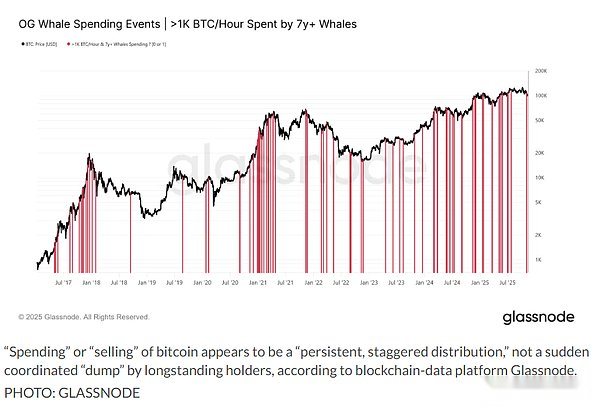
Wu Yu, Jin Shi Data
Bitcoin fell below the key $100,000 mark last week, and recent selling by “whales” (investors who hold large amounts of the cryptocurrency) and other long-term holders has been a significant driver of the recent weakness in the price.
Most blockchain analysis companies define “whales” as individuals or institutions holding 1,000 or more Bitcoins.Although most whales are unknown, blockchain data can still provide clues to their activities by tracking their cryptocurrency wallets.
The data shows,Some “giant whales” have recently accelerated the pace of Bitcoin selling.Some analysts said the phenomenon was noteworthy but not necessarily a signal of panic.They pointed out,The recent sell-off may reflect steady profit-taking rather than panic selling, a pattern consistent with previous bull cycles.
Martin Leinweber, head of digital asset research and strategy at MarketVector Indexes, said such sell-offs may reflect “planned asset allocation.””Some Bitcoin investors bought when the price was in the single digits and waited for so long. Now there is finally enough liquidity to sell without completely destroying the market,” he told MarketWatch.
Although cryptocurrency bulls have recently complained about drying up market liquidity, the ease of buying and selling Bitcoin has improved significantly compared to a decade ago.
However, analysts at blockchain analysis firm CryptoQuant said that what is worrying is thatThe recent sell-off by “Whales” coincides with worsening market sentiment and slowing buying, which could put further pressure on Bitcoin prices.Dow Jones market data showed that the largest cryptocurrency was close to $19,400 on Friday, its lowest level since May 6.
Comparison between past and present
The selling of Bitcoin by long-term and large holders is not unique to the current cycle. Analysts at blockchain data platform Glassnode wrote in a recent report that there are signs that the recent selling is driven by profit-taking rather than panic.
Specifically,A “whale” wallet that has held Bitcoin for more than seven years and sells more than 1,000 Bitcoins every hour has a regular and uniform selling behavior over a period of time.(See chart below, data as of last Thursday, November 13).

The selling behavior of the “giant whale” appears regular and uniform over a period of time.
The significance of the $100,000 mark
Meanwhile, Cory Klippsten, CEO of Bitcoin-focused financial services firm Swan Bitcoin and a long-time Bitcoin investor, said,Heavy selling by “whales” over the past few months appears to be correlated with Bitcoin’s $100,000 mark– Many early adopters have long regarded this level as the psychological threshold for taking profits.
“Since entering this space in 2017, a lot of early holders I know have talked about the $100,000 number,” Clipsten told MarketWatch. “For some reason, people always talk about selling some of their positions at this price.”
Glassnode data shows,Since Bitcoin topped $100,000 for the first time in its history in December 2024, selling by long-term holders has intensified.
Potential warning signs
However, CryptoQuant analysts wrote in a recent report that one changing factor is the market’s ability to withstand the sell-off.When long-term holders sold off Bitcoin late last year and early this year, other buyers stepped in to support the price, but that dynamic appears to have shifted..
The flow of funds for investment products can reflect weak demand – Dow Jones market data shows that as of last Thursday, Bitcoin exchange-traded funds (ETFs) had outflows of US$311.3 million throughout the week, which is expected to be the fifth consecutive week of outflows, the longest continuous outflow period since the week ending March 14 (when there were five consecutive weeks of outflows).
In the past five weeks, Bitcoin ETFs have experienced cumulative outflows of US$2.6 billion, the largest five-week outflow since the week ending March 28 (when there was an outflow of US$3.3 billion).
Recent price action has also brought the $100,000 mark back into focus.As of press time, Bitcoin is still trading below this level.Some technical analysts said,The market’s failure to regain this key level could trigger more profit-taking.
To make matters worse,The overall macroeconomic environment is not conducive to risk assets.Joel Kruger, market strategist at LMAX Group, which operates a foreign exchange and cryptocurrency exchange, noted that this resulted in the liquidation of some long positions.”We believe the market is overly optimistic heading into the fourth quarter, stemming from analysis of seasonal trends that have historically outperformed the period,” Krueger wrote in a letter to MarketWatch.
Krueger pointed out that overall risk assets, including Bitcoin, are again under pressure as investors lower their expectations for a December interest rate cut by the Federal Reserve and weak labor market data raises economic concerns.
Thaler is still adding to his holdings
Despite this, one of the largest known Bitcoin “whales” continues to buy.
Michael Saylor, chairman of the software company Strategy Inc. (now widely regarded as a leveraged Bitcoin investment target), said on CNBC on Friday,Companies have been “accelerating” their Bitcoin purchases, and will announce buying status on Monday morning.
As of Friday, Strategy held more than 640,000 Bitcoins, accounting for more than 3% of the cryptocurrency’s current total circulation of 19.9 million.Representatives from Strategy did not immediately respond to an email seeking comment.






